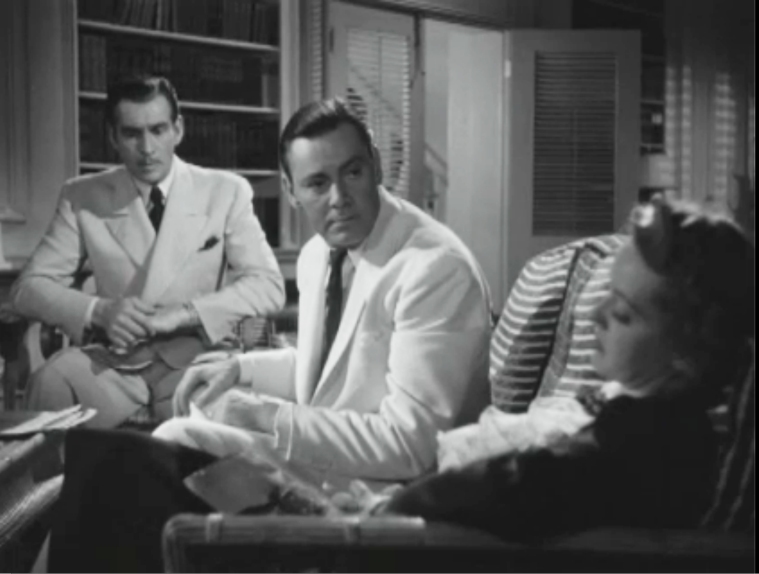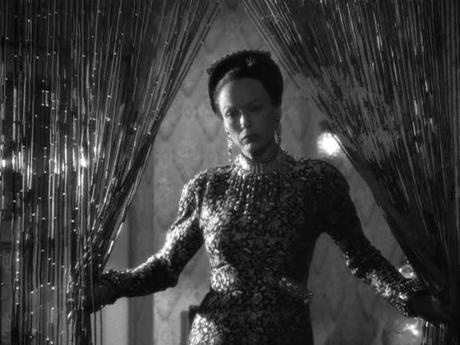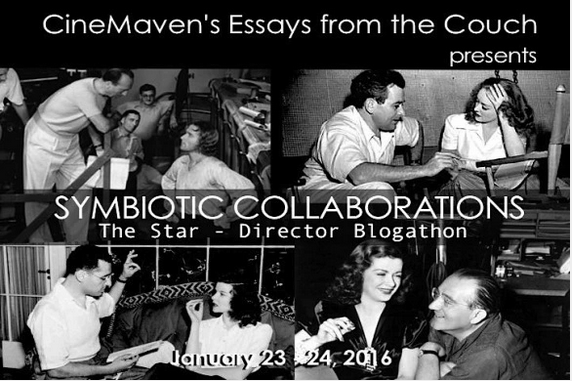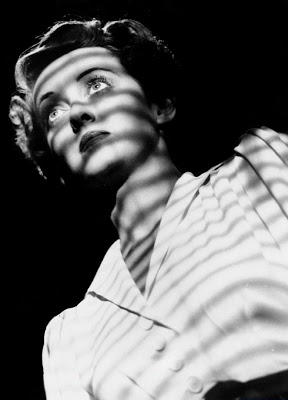
Director William Wyler shows Bette Davis the best way to shoot somebody. Image: Pinterest
*Spoiler Alert*
They created the best opening scene in the history of cinema: On a moonlit night, on an isolated rubber plantation in Malay, a woman follows a man out of a house. As he stumbles down the stairs of the veranda, she fires at him repeatedly with a handgun, even after he’s dead.
In films from this era, a moonlit night and an exotic location often suggest adventure and romance. But here, in The Letter (1940), director William Wyler and star Bette Davis give us cold-blooded murder.
The Letter is based on a story + play by W. Somerset Maugham. The plot is modelled on a real-life murder in Kuala Lumpur in 1911.
Davis plays an English woman accused of a murder which she claims was self defence. However, the discovery of an incriminating letter contradicts her story and leads to tragic events.
It’s a film of secrets. Director of Photography Tony Gaudio drapes shadow across the sets like a fine fabric; we know there’s more to the story than we’re allowed to see. But he also teases sharp light through slats, revealing the truth about Davis’ character:
As for Wyler, he knew how to pull haunting performances from his actors. In one scene, Davis’ lawyer (James Stephenson) tells her husband (Herbert Marshall) how much it cost to suppress the incriminating letter. It’s a lot of money – a lifetime of savings – and Marshall makes us feel the weight of this unwelcome news.
It’s a remarkable scene, made more powerful by a refreshingly-subdued Davis, who remains slumped in the corner of a sofa. While Stephenson and Marshall have a terse exchange about the letter, Davis suddenly amps the tension with a quiet, “Let him see it.”
In our opinion, The Letter contains one of Davis’ best performances, because Wyler taught her how to Not Act.

Davis calmly tells James Stephenson (left) to open the letter.
It was on the set of their first collaboration, Jezebel (1938), that Wyler began to temper Davis’ tendency to overact. In A Talent For Trouble: The Life Of Hollywood’s Most Acclaimed Director, William Wyler, author Jan Herman describes Wyler and Davis at work on this film.
“As filming continued [on Jezebel],” writes Herman, “Wyler convinced Davis that every moment need not be played with equal force. During rehearsals he had realized that was her greatest weakness” (p.212).
Wyler helped Davis learn how to pace herself, and we see the results in The Letter. When Davis is brought to a sketchy neighbourhood to pay off the dead man’s widow (Gale Sondergaard), a restrained Davis allows an exotic Sondergaard to make an impressive entrance, complete with dramatic backlighting.
(Incidentally, Wyler turns this scene into a religious ceremony of sorts – Davis seeking absolution from a priestess in an opium-den temple.)

Gale Sondergaard is calling the shots. Image: PaperBlog
Later, Davis said of Wyler, “No detail, however minor, ever escaped him. He would probe like a fiend, then turn sarcastic; or he’d be aloof and drive you crazy” (ibid).
He drove a lot of people crazy. Wyler was famous for not telling actors what he was looking for. “I’ll know it when I see it,” he said. It was not unusual for him to re-shoot a scene multiple times, while actors became increasingly exasperated. He was a perfectionist, as was Davis – which sometimes led to fierce arguments.
The two would collaborate a third and final time, with The Little Foxes (1941). Their three collaborations are remarkable films, but our favourite is The Letter, which received seven Oscar nominations, including Best Actress and Best Director.
Notes:
- You can read more about William Wyler’s life, including his romantic collaboration with Bette Davis, HERE.
- For more background information on the making of The Letter, read The Lady Eve’s Reel Life review HERE.
The Letter: starring Bette Davis, Herbert Marshall, James Stephenson. Directed by William Wyler. Written by Howard Koch. Warner Bros. Pictures, Inc., 1940, B&W, 95 mins.
This post is part of the Symbiotic Collaborations Blogathon hosted by CineMaven’s Essays from the Couch. Click HERE to see all the fab entries.
















Great post. I need to see this ASAP!
LikeLiked by 2 people
What?! You haven’t seen this already? You, of all bloggers?
Well, you have some great viewing ahead. Looking forward to seeing your thoughts.
LikeLiked by 1 person
IKR!
LikeLike
Love this film (and you know that Maugham is one of my fave writers). I also dig your review!
LikeLiked by 2 people
Thanks! Am ashamed to say I’ve read very little Maugham, only Of Human Bondage. Must make him more of a priority in 2016.
LikeLike
Excellent post! Oddly enough, I just rewatched this yesterday for the first time in several years. I particularly like your analysis of the shadows and the light through the slats, as well as the examples you gave of Davis’s underacting. And that’s quite an opening scene, isn’t it?
LikeLiked by 1 person
I absolutely LOVE the opening scene. The first time I saw this, many years ago, I replayed the opening scene a few times because it was so good.
Did you enjoy your recent viewing more than, or less than, your earlier viewing(s)?
LikeLiked by 1 person
I would say I liked it more this time through, which was only my second viewing. Because I knew where the plot was going (although I didn’t remember every single detail), I was able to pay closer attention to other things, especially the performances and the cinematography.
LikeLiked by 1 person
A superb film!! I need to see the original. So love to hear Herbert Marshall speak.
LikeLiked by 1 person
Yes, I’d like to see the original film, too, with the fab Jeanne Eagels. I hear she was a perfect Leslie in that film. Thanks for stopping by. 🙂
LikeLiked by 1 person
😍 Yet another film I haven’t seen. On my list now. Love the idea of teaching someone not to act. That not every scene needs to be played with equal force. Excellent post.
LikeLiked by 1 person
Sarah, you are in for a real treat with this film. If you see one classic film this year, let it be The Letter. It’s that good!
Thanks for your kind comments. 🙂
LikeLiked by 1 person
Will do. 🙂 Watched the Christmas Carol last month that you suggested. Interesting… I love that story and this one showed Scrooge as unpleasant as the book made him out to be. It was cool seeing a new version. (It was a bit difficult to watch with the quality of the film, though.)
LikeLike
Yes, the quality wasn’t so great, which I should have warned people about.
LikeLike
Wyler truly brought out the best in La Davis, and the three films they made together and her performances in particular, are endlessly fascinating to me.
LikeLiked by 2 people
Yes, endlessly fascinating is a good way to describe their films. All superb in their own way. It’s really too bad Wyler and Davis didn’t make more films together…however, maybe it’s best to leaving us wanting more. 🙂
LikeLiked by 1 person
I was amazed at how uncharacteristically subdued she was in this one, which seemed all the more effective given her usual forcefulness. I agree – one of her very finest performances!
LikeLiked by 2 people
So true. In an interview with Dick Cavett, Davis said she thought an actor should show the audience he’s “working”. Not sure I agree with that, but I think it explains her usual approach to acting.
LikeLiked by 2 people
A nice post about one of my favorite films (and collaborations) in Hollywood history. I completely agree that the opening scene of the film is one of the best in history and any aspiring actor should study it. Davis’ gestures are absolutely flawless, even the way she lowers the gun after she shoots.
Tam
LikeLiked by 2 people
Yes, you’re absolutely right. Davis is pitch-perfect here, even – as you said – the way she lowers the gun when she’s finished shooting the poor slob.
LikeLiked by 1 person
I’m probably the least decisive person ever so it’s hard for me to make a list of Bette favorites (she’s one of my top actresses), but The Letter is one that I definitely count among her best. Under Wyler’s direction, every small second of her performance is on-point. What an opening, and what a film! Enjoyed your post!
LikeLiked by 2 people
Yes, good point about every small second – even Bette’s mannerisms when she’s not speaking are always in character. I hadn’t thought about it quite like that. They really were a great pair, she and Wilder, no? It must have made for some very interesting days on the set…
LikeLiked by 1 person
This movie holds a special place in my heart. I introduced it with Robert Osborne during their 15th Anniversary which featured Guest Fan Programmers. I look forward to reading this. Thanx for joining the blogathon.
LikeLike
How I love this film. I’m a big fan of Maugham’s, who creates such complex roles for his heroines (check out how many of them have won Oscars). This pairing is inspired. Love your image of the slats–how did I not notice the significance of that? I really need to view this one again!
LikeLiked by 1 person
You’re right – so many of his heroines have won Oscars. I’d never really considered that before. Thanks for dropping by!
LikeLike
“The Letter” has so much to offer, and I’m glad you’ve chosen to showcase it. I always enjoy a Wyler and Davis collaboration!
LikeLiked by 1 person
Yes, what’s not to love about a Wyler & Davis collaboration? They really knew their stuff.
LikeLiked by 1 person
They did, indeed! I thoroughly enjoyed reading your contribution. It’s an iconic “symbiotic collaboration.”
LikeLiked by 1 person
Great post, that really is the best character opening in all of film.
LikeLiked by 1 person
It is, isn’t it? You just can’t beat Bette Davis shooting the living daylights out of someone.
LikeLike
It really isn, isn’t it? You know you’re in for a wild time with an opening like this.
LikeLike
I love this movie and your description of it. Been in the mood to rematch it, actually. Thanks for the Push!! This is up there close to my favorite Davis performances too. Great choice all around.
Aurora
LikeLike
Thanks! Yes, The Letter is a movie that should be watched often. It never gets old, does it?
LikeLike
Now you mention it, it is a pretty cool opening scene (and it wasn’t what I expected when I watched it for the first time). This is a movie with its flaws, but I think I love it all the more for them. And I’ve always thought that most people don’t really *get* what it’s about – of course, I see you’re an exception 😉
Although impossible to really decide, I think this is my favourite Davis/Wyler collaboration.
LikeLike
Same here – I wasn’t expecting that opening scene the first time I saw the film. I saw it as a young gal and I thought, “They made movies like this back then?” It was the 1st Bette Davis movie I saw and I became an instant fan.
LikeLike
Wow! This movie sounds fantastic, thanks for lovely recommendation!
LikeLiked by 1 person
You must see this! I’d be really interested to read your analysis. (Hint hint) 😉
LikeLike
Awesome recommendation – she’s the best.
LikeLiked by 1 person
Yes, I think she is one of the best. I can’t imagine anyone else playing her role in this version. She’s brilliant.
LikeLiked by 1 person
I don’t recall seeng this one, Ruth, and with that opening, I’m sure i’d remember if I did. That still of Ms Davis in the shadows is really something, isn’t it? Wyler knew her quite well and, consequently, how to use her for greatest impact. “Less is more, Bette.”
LikeLiked by 1 person
Oh yes, you’d remember this one! I adore Bette in everything, but you’re right – less is definitely more.
John, you’ve got to see this one! If you only see one classic film this month, make it The Letter.
LikeLiked by 1 person
I watched this yesterday afternoon and loved it. You were so right, Ruth.Of course, there’s no mistaking Bette Davis in a film but her minimalist acting in this one is so unlike her. Too bad there are no outtakes from that first few days of filming. I envision her chewing up the scenery and Wyler shouting, “Cut, cut, CUT!”, again, and again, and again. I’d pay double to see “The Making of ‘The Letter'”. 🙂
LikeLiked by 1 person
Bahaha!! I’m with you – I’d also pay double to see “The Making of”. Glad you were able to see it & happy to hear you enjoyed it.
LikeLiked by 1 person
I haven’t seen The Letter, but I was very impressed with Bette in Jezebel. I later read she didn’t like working with Wyler at first, but later they gow along. A good director knows how to mold the actors – and Wyler was a master in this craft.
Kisses!
Le
LikeLiked by 1 person
Yes, Bette and Wilder had two different styles, that’s for sure – she called him a dictator(!). However, they recognized talent in each other, and we have some great films as a result. Thanks for dropping by!
LikeLike
I like reading about different actors and how they involved and I think your blog is plethora of information…this was a wonderful post.
LikeLiked by 1 person
Thanks very much! The Letter is a terrific movie if you ever have the chance to see it.
LikeLiked by 1 person
I will watch it tomorrow 😀 good use of holiday
LikeLiked by 1 person
Great background info on the film. We often forget the impact of a director on an actor’s performance. I want to see Jezebel now.
The opening scene was absolutely gripping. It created a dramatic question for the viewer. Will she get away with murder?
I wrote a short essay (500 words) on The Letter called “Three Reasons Why Women Have An Affair.” If you would like to read it, I am open to any feedback: https://christopherjohnlindsay.wordpress.com/2016/07/30/the-letter-1940/
LikeLiked by 1 person
Thanks for the link! I’m out of town with limited web access this week, but will check it out when I get back. Thanks for stopping by. 🙂
LikeLiked by 1 person
Reblogged this on WILDsound Writing and Film Festival Review.
LikeLiked by 1 person